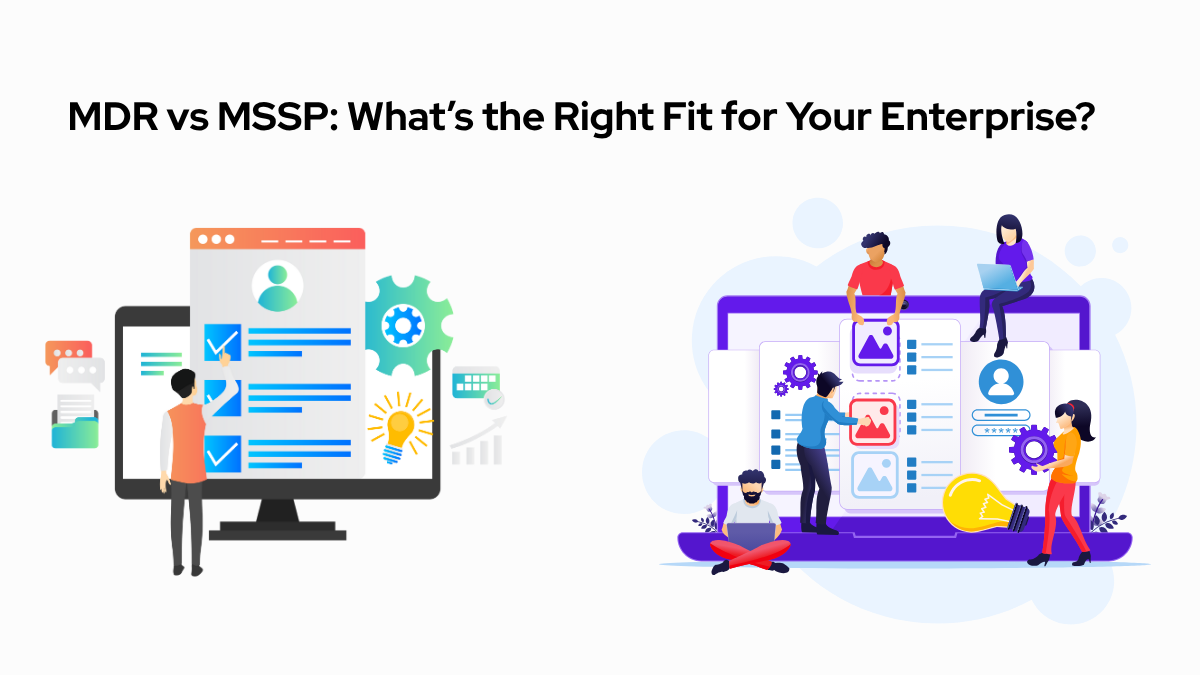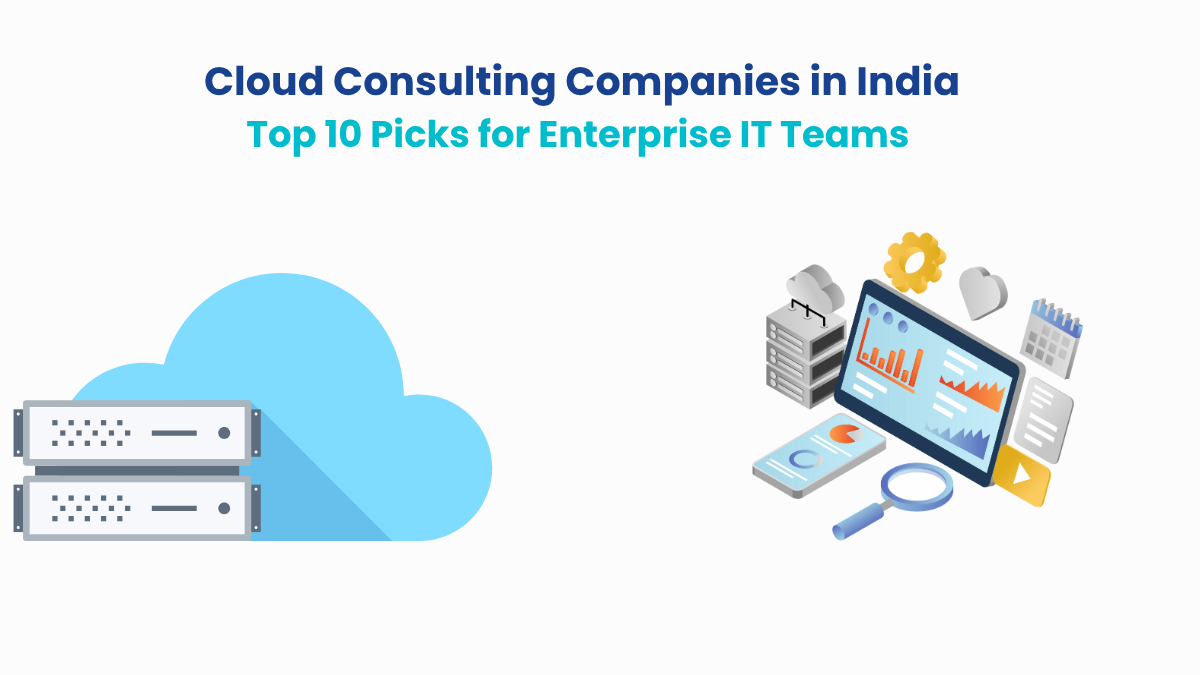If you’re here, you’re not asking what MDR and MSSP are. You already know the difference. The real question is: Which model actually fits your enterprise, right now?
Maybe your internal team is buried in alerts, and you’re wondering if your MSSP is doing anything beyond forwarding logs. Maybe the board wants faster incident response, and you’re considering whether MDR is the missing piece. Or maybe you’re just trying to avoid another fragmented solution that won’t scale.
This isn’t a definition lesson. It’s an operational decision.
While MDR and MSSP both promise 24/7 coverage and threat detection, the difference lies in what happens next. MSSPs keep watch. MDRs fight back.
This guide is for security leaders trying to make the right operational choice. We’ll unpack when each model makes sense, where they overlap, and how they differ. We will also walk you through how to map the right fit to your enterprise’s maturity, risk appetite, and security priorities.
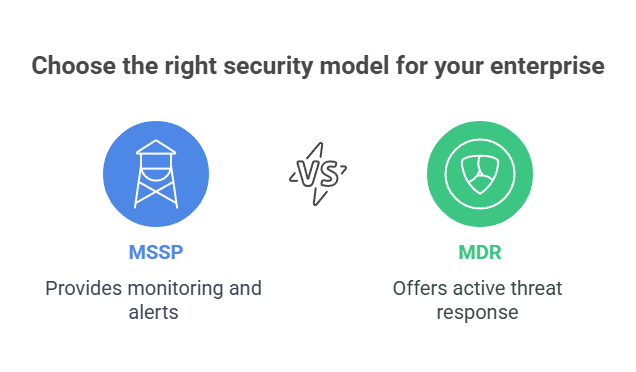
MSSP vs MDR: What’s the Real Difference and When Does Each Make Sense?
Let’s be clear: MSSPs and MDRs aren’t competitors; they’re complementary. But their operational DNA is different. Let’s understand how they differ from each other:
What MSSPs Do
A Managed Security Service Provider (MSSP) typically handles:
- Monitoring your security devices (firewalls, VPNs, IDS/IPS)
- Managing log data through a SIEM
- Alerting you to threats based on predefined rules
- Providing compliance reports and device uptime visibility
Think of MSSPs as the eyes and ears of your environment, watching and reporting.
What MDR Providers Do
Managed Detection and Response (MDR) providers focus on:
- Actively detecting threats using endpoint and behavioral data
- Investigating suspicious activity across your environment
- Containing incidents like isolating a machine or disabling a user
- Giving you a complete story of what happened, how, and what changed
MDRs are the arms and reflexes; they detect, decide, and act.
So, when does each model fit best for your enterprise? Here’s how you can decide.
How Enterprises Decide: 8 Real-World Triggers That Signal It’s Time for MDR or MSSP
Choosing between MDR and MSSP isn’t about features; it’s about fit. The right choice becomes clearer when you map it to the reality you’re operating in. Here are eight situations where the need reveals itself.
#1. You’re getting breached, but can’t explain how.
→ You need MDR.
If attackers are slipping through undetected, or incidents are discovered too late, monitoring alone won’t cut it. MDR brings active threat hunting, telemetry analysis, and fast response. This is ideal when you need to contain what your tools missed.
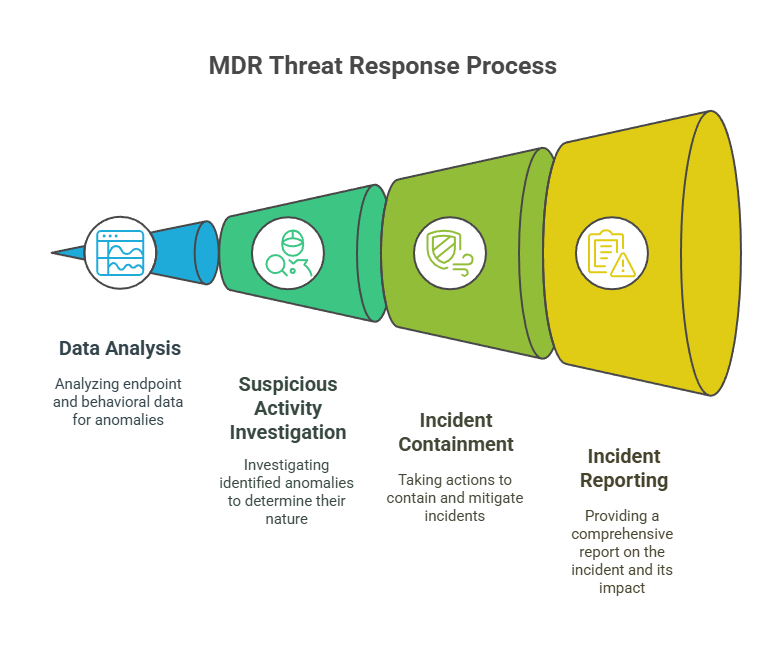
#2. You’ve got tools in place, but no one’s watching after hours.
→ You need MSSP.
Firewalls, SIEM, and endpoint protection don’t help if no one’s on duty overnight. MSSPs fill that gap with 24/7 monitoring and alert triage, so you’re not flying blind when it matters most.
#3. Your compliance audits are getting painful.
→ You need MSSP.
HIPAA, PCI DSS, ISO 27001 – whatever the framework, MSSPs provide the logging, retention, and reporting discipline you need. They help document what’s being monitored and offer structured visibility to keep auditors satisfied.
#4. You’re drowning in alerts with no time to investigate.
→ You need MDR.
When your team spends more time closing tickets than investigating actual threats, MDR steps in with automated triage and analyst-led investigations. The result: less noise, more action.

#5. You’re moving to the cloud and losing visibility.
→ You need MDR.
Cloud migrations break traditional perimeters. MDR adapts to these environments with behavioral analytics, cloud telemetry monitoring, and endpoint detection, so threats don’t hide in SaaS or hybrid setups.
#6. You’ve invested in security tech but response takes hours.
→ You need MDR.
It’s one thing to detect a threat. It’s another to contain it quickly. If incidents linger for hours before action is taken, MDR gives you access to analysts who act on your behalf, often within minutes.

7. Your team is small and stretched thin.
→ You need MSSP.
When internal resources are limited, MSSPs act as an extension of your team. They maintain your tools, monitor alerts, and escalate what matters, freeing your staff to focus on strategic security initiatives.
8. You have a SOC but need sharper detection and faster response.
→ You need MDR.
Many enterprises operate a basic SOC with monitoring and escalation. MDR enhances that foundation with deep threat visibility, attacker context, and response capabilities. It closes the gap between knowing and acting.
If you’re looking to elevate your SOC into a modern, proactive defense hub, check out our eBook on Five Essential Steps to SOC Transformation. This guide is packed with practical solutions for overcoming SOC limitations and building resilience.

Having said that, situational triggers give you directional clarity. But when you’re facing a complex security roadmap, you need more than symptoms, you need strategy. The next section helps you think at that level.
MDR vs MSSP: The Five-Framing Lens CIOs Use to Make the Call
Choosing between MDR and MSSP isn’t just about solving today’s problem. It’s about aligning with how your enterprise wants to operate, respond, and grow. Below are five strategic lenses that security leaders use to decide which path is operationally right for them.
| Decision Lens | When MSSP Fits Best | When MDR Fits Best |
| Team Capability | You already have experienced security engineers or a basic SOC team. MSSPs handle the monitoring, while your internal team investigates and responds. | You don’t have or don’t want to build an in-house detection and response capability. MDR providers give you access to elite analysts and threat hunters. |
| Response Expectations | You’re comfortable with escalated alerts and managing incident response internally within business-hour SLAs. | You need sub-30-minute response time even at 3 am., and want the provider to isolate threats and take first action. |
| Compliance Burden | Your primary driver is regulatory alignment (e.g., PCI DSS, DPDPA, ISO 27001). MSSPs support structured logging, retention, and audit support. | Compliance is important, but visibility into root cause and breach resolution speed is more urgent. MDR supports RCA and post-incident documentation. |
| Tech Stack Ownership | You prefer outsourcing infrastructure management (SIEM, firewalls, IDS/IPS). MSSPs provide configuration, tuning, and uptime reporting. | You already own detection tools or plan to invest in them, but need expert support to use them effectively. MDR integrates into what you own. |
| Long-Term Security Vision | You’re optimizing for coverage, operational continuity, and cost-efficiency. MSSP is the conservative, compliance-first choice. | You’re optimizing for resilience, advanced detection, and threat-informed defense. MDR fits when cybersecurity is a board-level priority. |
For most enterprises, the real challenge isn’t picking between MDR and MSSP. It’s making them work together. Security today is a moving target. And in a world of evolving threats, compliance pressures, and resource gaps, the best defense is often a hybrid one: monitoring and response, infrastructure support, and expert-led containment.
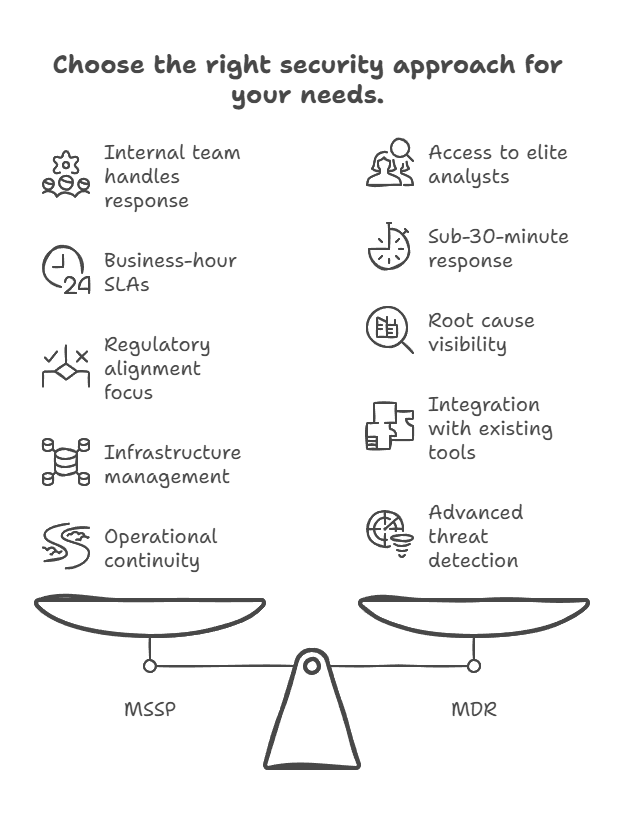
That’s why forward-thinking providers like Datacipher have reimagined the delivery model. Instead of forcing you to choose, Datacipher blends the strengths of both MDR and MSSP into their offerings. Let’s find out more.
MDR vs MSSP? With Datacipher, You Don’t Have to Settle
Some providers are great at managed detection. Others specialize in infrastructure monitoring. Datacipher does both, a an enterprise-grade level.
Whether you’re looking to outsource log management and compliance reporting (MSSP), or you need expert-led threat response and incident containment (MDR), Datacipher delivers deep expertise in both domains. And when your security posture demands more, the two layers can work seamlessly together, on your terms.
Here’s why Enterprises trust Datacipher for MSSP and MDR needs:
- Modular services: Choose what you need, be it MSSP, MDR, or both with no forced bundling.
- Mature delivery: Each service is independently robust, with dedicated processes, tech, and talent.
- Layered when needed: You can start with MSSP and evolve to MDR, or vice versa. Datacipher adapts to your security maturity curve.
- Advisory-first: Our team helps you decide the right fit for your enterprise based on real risks, not just service menus.
A large healthcare enterprise partnered with Datacipher for MSSP services. They were primarily interested on our 24/7 monitoring and compliance reporting capabilities. Months later, a spike in lateral movement attempts triggered a deeper review. Rather than replacing their setup, they layered our MDR service on top. The result was instant containment, rapid incident forensics, and a stronger overall security posture. And all this happened without disrupting existing operations.
Are you looking to strengthen detection or outsource monitoring? Whatever you need, our experts can help you align your security operations with what your business actually needs. Talk to our experts today!
Frequently Asked Questions
#1. Can we use both MDR and MSSP together?
Yes. Many enterprises layer MDR over MSSP to combine infrastructure monitoring with active threat response. This hybrid model offers 24/7 visibility and containment without overloading internal teams. This is ideal for organizations scaling their security maturity.
#2. Does MDR replace my existing security tools?
Not necessarily. Most MDR providers integrate with your current stack, like EDR, SIEM, cloud telemetry, etc., rather than replacing it. This makes it easier to enhance threat detection and response without a rip-and-replace effort.
#3. Can an MSSP act on threats, or do they just alert us?
Mostly alert. Traditional MSSPs monitor and escalate. They don’t usually isolate endpoints or contain threats. That’s where MDR excels, with hands-on response and deep investigation capabilities.
#4. How fast is MDR response compared to MSSP?
MDR is faster. MDR teams often respond within 15–30 minutes, containing threats proactively. MSSPs typically follow alert-and-escalate protocols, which means response actions are your responsibility unless customized otherwise.

